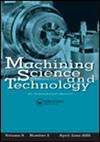An experimental investigation on the effects of combined application of ultrasonic assisted milling (UAM) and minimum quantity lubrication (MQL) on cutting forces and surface roughness of Ti-6AL-4V
IF 2.6
4区 工程技术
Q2 ENGINEERING, MANUFACTURING
引用次数: 6
Abstract
Abstract Ti-6Al-4V is widely used in aerospace, medical and defense industries where materials with superior characteristics are needed. However, Ti-6Al-4V is categorized as a difficult-to-cut material, and machining of this alloy is highly challenging. Ultrasonic Assisted Milling (UAM) is a quite recent method to facilitate the machining of difficult-to-cut materials. This method has numerous advantages over the Conventional Milling (CM) method, such as reduced cutting forces and increased surface quality. Besides, Minimum Quantity Lubrication (MQL) is an alternative cooling method to enhance the process efficiency with respect to conventional cooling methods. Cutting force and surface roughness are essential measures to evaluate the cutting performance of a machining process. However, the simultaneous effects of implementing MQL and ultrasonic vibrations in milling operations are not much researched yet. In this study, the combined effects of UAM and MQL on cutting forces and surface roughness during the machining of Ti-6AL-4V are investigated. Results show that the combination of MQL and UAM enhances the cutting forces in rough cutting operations and the surface roughness in both finish and rough cutting operations significantly compared to conventional processes. Consequently, it is concluded that simultaneous implementation of UAM and MQL enhances overall cutting performance in end-milling operation of Ti-6Al-4V.超声辅助铣削(UAM)和微量润滑(MQL)联合应用对Ti-6AL-4V切削力和表面粗糙度影响的实验研究
摘要Ti-6Al-4V广泛应用于航空航天、医疗、国防等对材料性能要求较高的领域。然而,Ti-6Al-4V被归类为难以切割的材料,这种合金的加工极具挑战性。超声辅助铣削(UAM)是一种较新的方法,以促进难切削材料的加工。与传统铣削(CM)方法相比,该方法具有许多优点,例如减少切削力和提高表面质量。此外,最小量润滑(MQL)是一种替代冷却方法,以提高过程效率相对于传统的冷却方法。切削力和表面粗糙度是评价加工过程切削性能的重要指标。然而,在铣削作业中同时实施MQL和超声波振动的影响还没有太多的研究。研究了UAM和MQL对Ti-6AL-4V加工过程中切削力和表面粗糙度的综合影响。结果表明,与常规工艺相比,MQL和UAM的组合可显著提高粗切削加工的切削力和精加工和粗切削加工的表面粗糙度。综上所述,同时实施UAM和MQL可以提高Ti-6Al-4V立铣削时的整体切削性能。
本文章由计算机程序翻译,如有差异,请以英文原文为准。
求助全文
约1分钟内获得全文
求助全文
来源期刊

Machining Science and Technology
工程技术-材料科学:综合
CiteScore
5.70
自引率
3.70%
发文量
18
审稿时长
6 months
期刊介绍:
Machining Science and Technology publishes original scientific and technical papers and review articles on topics related to traditional and nontraditional machining processes performed on all materials—metals and advanced alloys, polymers, ceramics, composites, and biomaterials.
Topics covered include:
-machining performance of all materials, including lightweight materials-
coated and special cutting tools: design and machining performance evaluation-
predictive models for machining performance and optimization, including machining dynamics-
measurement and analysis of machined surfaces-
sustainable machining: dry, near-dry, or Minimum Quantity Lubrication (MQL) and cryogenic machining processes
precision and micro/nano machining-
design and implementation of in-process sensors for monitoring and control of machining performance-
surface integrity in machining processes, including detection and characterization of machining damage-
new and advanced abrasive machining processes: design and performance analysis-
cutting fluids and special coolants/lubricants-
nontraditional and hybrid machining processes, including EDM, ECM, laser and plasma-assisted machining, waterjet and abrasive waterjet machining
 求助内容:
求助内容: 应助结果提醒方式:
应助结果提醒方式:


